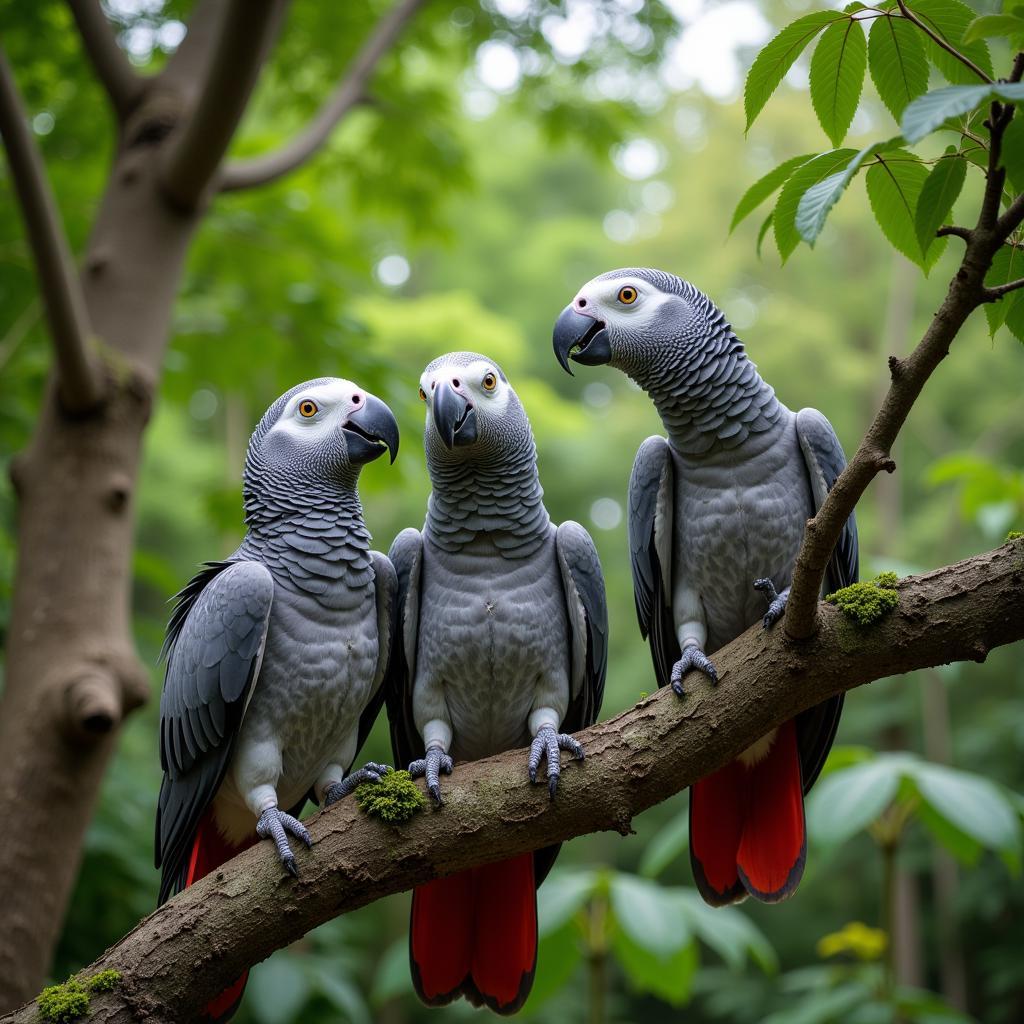African Grey Parrot Adaptations: A Look at Nature’s Master Mimic
The African grey parrot, a resident of the dense forests of Central and West Africa, is renowned for its intelligence and exceptional ability to mimic human speech. But these are just two facets of this remarkable bird. A deeper dive into the African Grey Parrot Adaptations reveals a fascinating story of how this species thrives in its natural habitat. Let’s explore the unique physical and behavioral adaptations that make this parrot a true marvel of the avian world.
A Beak Built for Success: The African Grey Parrot’s Powerful Tool
The African grey parrot’s most obvious adaptation is its strong, hooked beak. This powerful tool, more robust than that of many other parrot species, is perfectly suited for a diet of seeds, nuts, fruits, and even tree bark. The upper mandible is larger and curves downwards, enabling the parrot to exert significant force to crack open hard-shelled nuts and seeds. This beak also aids in climbing, acting as a third “foot” as the parrot navigates the branches.
More Than Just Mimicry: Communication in the Wild
While the African grey parrot’s talking ability is widely recognized, its natural vocalizations are equally impressive. These parrots use a complex system of calls, whistles, and even body language to communicate within their flocks.  African Grey Parrot Flock: Communicating in the Canopy These vocalizations serve various purposes, from warning others of predators to strengthening social bonds.
African Grey Parrot Flock: Communicating in the Canopy These vocalizations serve various purposes, from warning others of predators to strengthening social bonds.
A Colorful Camouflage: Blending In to Stand Out
One might assume that the striking silver-grey plumage of the African grey parrot would make it an easy target for predators. However, this coloration is actually a clever camouflage tactic. african animals camouflage In the dappled light of the forest canopy, the parrot’s feathers blend remarkably well with the shadows and sunlight, making it harder for predators like eagles and snakes to spot them.
Navigating the Forest: A Study in Sensory Perception
African grey parrots possess exceptional eyesight and hearing, crucial for survival in their environment. Their eyes, positioned on the sides of their heads, provide a wide field of vision, enabling them to detect predators from various angles. Their sharp hearing allows them to identify the calls of their flock mates and pinpoint the location of ripe fruit or potential threats.
The Power of Intelligence: Problem-Solving in Parrots
One of the most remarkable African grey parrot adaptations is their impressive intelligence. Studies have shown that these parrots possess cognitive abilities comparable to those of a young human child. They are adept at problem-solving, can recognize themselves in a mirror, and have excellent memories. african grey parrot species This intelligence, coupled with their social nature, contributes to their complex communication skills and ability to thrive in their challenging environment.
Frequently Asked Questions about African Grey Parrot Adaptations
How does the African grey parrot’s beak help it to survive?
The strong, hooked beak is essential for their diet, allowing them to crack open tough nuts and seeds. It also aids in climbing and acts as a tool for preening and manipulating objects.
Why is the African grey parrot’s coloration considered an adaptation?
Their silver-grey plumage, while seemingly conspicuous, provides effective camouflage in the dappled light of the forest canopy, making them less visible to predators.
What is special about the African grey parrot’s intelligence?
They exhibit advanced cognitive abilities, such as problem-solving, self-recognition, and excellent memory, surpassing those of most other bird species.
How do African grey parrots use vocalizations in the wild?
They have a complex system of calls, whistles, and body language for communication, used for various purposes, including warning signals, mating rituals, and maintaining social bonds.
Why are African grey parrots considered to be good pets?
Their intelligence, social nature, and exceptional ability to mimic human speech make them engaging and interactive companions, though they require a significant commitment to care.
For further insights into the fascinating world of African wildlife, explore more articles on our website:
- Discover the captivating world of African famous birds.
- Delve into the unique characteristics of the African jungle animals list.
Contact us for any inquiries or assistance:
Phone: +255768904061
Email: kaka.mag@gmail.com
Address: Mbarali DC Mawindi, Kangaga, Tanzania
Our dedicated customer support team is available 24/7 to assist you.


